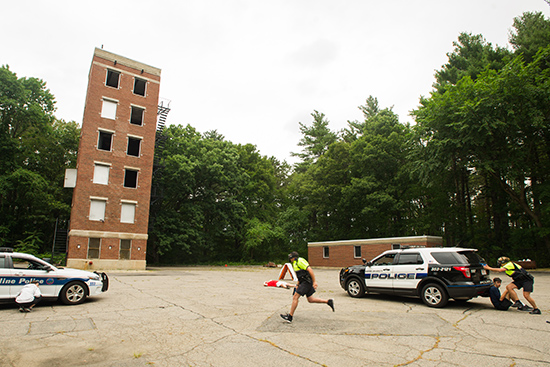BUPD and Brookline Police Train Together
Active shooter drills: a chance to get to know one another

BUPD training participants: officer Peter McCarron (from left), Sergeant Larry Cuzzi, officer Mike Vanaria, and officer Diane Smith. Photos by Cydney Scott
As two Boston University Police Department officers chat with the organizers of an outdoor student event, shots ring out—there’s a sniper in a third-floor window, gunning for the crowd. A second shooter emerges at ground level and blasts away with a shotgun in a well-planned ambush. The officers do their best to protect civilians while returning fire.
In this case, happily, it’s just a drill, and the officers’ guns have been modified to fire only Simunition, plastic shells loaded with water-based paint. The shotgun fires blanks.
Someone calls “hold your fire,” and the wounded get up and walk away. Now it’s time for a quick debriefing between the BU and Brookline police on the scene. One of the responding officers is kidded about taking a tumble in the middle of the action. “I’m not going to win Dancing with the Stars, that’s for sure,” he says with a smile.
Across three weeks in August, the BUPD ran nine joint training sessions with the Brookline Police Department, and getting to know one another was a big part of the purpose.
Because the coverage areas of the two departments overlap, “Brookline’s going to get there probably about the same time we get there,” says Scott Paré, BU’s deputy director of public safety and BUPD deputy police chief. With these exercises, “we get to know the faces, we get to know the first names. Then when it hits the fan, we are trusted faces, not strangers, and that makes working together much easier.”
The BUPD has conducted similar drills, with the Boston Police Department.

“It enhances our working relationship,” says Lieutenant Philip Harrington of the Brookline Police. “It’s always good to be familiar with certain faces and people you might see, so when things really do go bad, you’re not just meeting for the first time.”
In some of the drills, officers from the two departments respond side by side. On this morning, the two responding officers and the sniper are from the BUPD, while Brookline officers and interns play the parts of the other gunman and the three civilians. This particular scenario was chosen because of recent incidents of police officers being ambushed around the country, Harrington says. Not all of the scenarios are as violent.
“Sometimes you’re going to do scenarios where officers have a volatile situation and they’re using de-escalation techniques, talking to people and calming them down,” says Lieutenant Robert Casey, the BUPD training officer, who played the sniper. “It’s not all bang-bang, it’s shoot/don’t shoot. It’s important that our officers know when to de-escalate.”
Casey says the officers are trained to approach an active shooter, a protocol adopted after the 1999 shootings at Columbine High School, where police set up a perimeter and evacuated students rather than immediately confronting the shooters.
“The number-one priority in an active-shooter situation is to neutralize the threat,” says Casey. “That’s not the best day to be a police officer, but we’ve changed our tactics, because we know if we don’t go in now, it’s going to be worse.”
In a second scenario, the BU police work with two Fallon Ambulance Service EMTs to rescue a wounded officer under fire, using the ambulance as both transport and shield. The debriefing focuses on the best approaches to keeping the mass of the vehicle between personnel and the gunman.
The exercises are held at the Brookline Fire Department training facility behind Fire Station 6, on Hammond Street. Instead of taking officers off the street for an entire day, thereby increasing manpower costs, the BUPD scheduled sessions during all three shifts and had officers come for short periods while they were on duty.

Comments & Discussion
Boston University moderates comments to facilitate an informed, substantive, civil conversation. Abusive, profane, self-promotional, misleading, incoherent or off-topic comments will be rejected. Moderators are staffed during regular business hours (EST) and can only accept comments written in English. Statistics or facts must include a citation or a link to the citation.